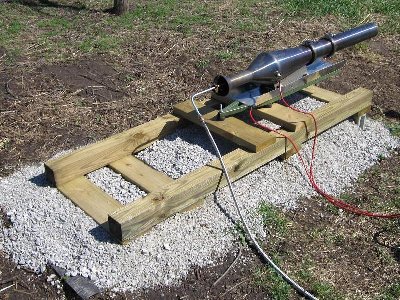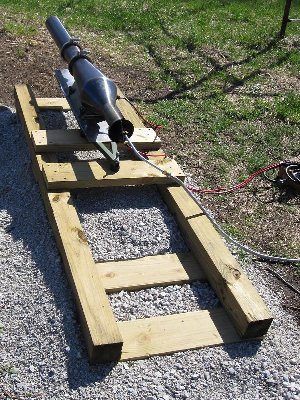Post
by larry cottrill » Sat Apr 10, 2010 2:32 am
Testing has been a rocky road. To start out, I was testing for a couple of weeks in February, but was hampered by terrible weather and got almost nothing accomplished. The client understandably became weary of this and insisted that I ship it down to Louisiana for them to test. It turned out that because of noise concerns, they could only test on weekends. Their main advantage besides warm weather was that they have BIG propane tanks manifolded together. Their main disadvantage was lack of experience testing unproven prototype designs, with all the interesting amusements that entails. And of course, all this was while working with the only fairly large engine I've ever designed and built. They managed some growling operation and some impressive bangs, but nothing resembling real power running, even though they tried multiple fuel pipe designs and many different pressure and flow scenarios. So a couple of weeks ago, the engine was shipped back to me.
My first job was to build a reasonable test stand to replace the snow-studded 2x6 plank used in the winter. What I came up with can be seen below -- basically a frame of two 4x4 rails with four 2x6 cross ties embedded in a crushed rock leveling bed. A couple more 2x6 pieces were added to the top at the rear. The engine is bolted to these with three 3/8-inch bolts in oversize holes, with heavy rubber pads to allow vibrational motion. Static thrust of the engine is not large because of its "linear" design (tailpipe and intake in opposition).
Using a high flow "high pressure" regulator (0-75 PSIG) and a high restriction fuel pipe, I was able to get resonant running within ten minutes. However, this produced low noise and low power. Examination of the fuel pipe showed its outlet was severely restricted. I made a new pipe of the "trilobite" design (squeezed into three lobes using a 3-jaw Jacobs chuck). I ran various tests, gradually squeezing it down until a really good velocity was obtained at around 60 PSIG delivery pressure. I was able to get good power runs early last week, but they lasted for only a few seconds. Hmmm ...
I finally tried adding a crude tailpipe extension. At an extension of a single inch, I was able to get arbitrarily long runs, but getting weak because of failing propane pressure at the tank. Even a 50 lb tank chills quickly once you've used up half or more of it, of course. I finally found a local RV place that would refill it by weight, and was back in business. However, the next few days were all some variation of cold, wet, thunderstorms, or extremely windy. We were under a tornado watch Wednesday this week for most of the day, with lots of large hail in various parts of the state.
Finally today I was able to get back to it, with the engine fitted with the original prototype of my ProTuner tuning sleeve. I tried a few different extensions, but 1 inch (25mm) still appears to be the best. I was able to get a run of about one minute when suddenly the propane hose burned through near the engine and dropped away. I was able to immediately shut off the propane with my SportThrottle valve (attached to the output of the regulator) with no damage to the test stand, even though there was a very impressive fireball briefly enveloping the area below the engine for just a brief instant.
In high pressure running, the spouting point of the fuel pipe is just outside the start of the intake throat, within the intake flare. The engine is perfectly self-starting in this configuration, without any need for auxiliary air.
I believe I now have the right setup for high pressure running, except for the need to re-design the fuel delivery setup so the hose will be farther from the intake flame. Once that is firmly established, I'll go back to the low pressure regulator and a low speed fuel pipe at what I call the "carburetion point" near the rear of the intake. I want to have a handle on both operational modes before I send this back to the client.
At this point, the client has over $3500 US invested in his pulsejet. I have assured him he will have a running engine without further expense.
L Cottrill
-
Attachments
-

- Basic layout of the test setup, seen
from the front of the test stand.
Photo Copyright 2010 Larry Cottrill
-

- View from the rear of the test stand.
Photo Copyright 2010 Larry Cottrill
-

- Just a different view from the front.
Photo Copyright 2010 Larry Cottrill
-

- Front end closeup. Note rubber mount pads to try to
absorb vibration. Photo Copyright 2010 Larry Cottrill